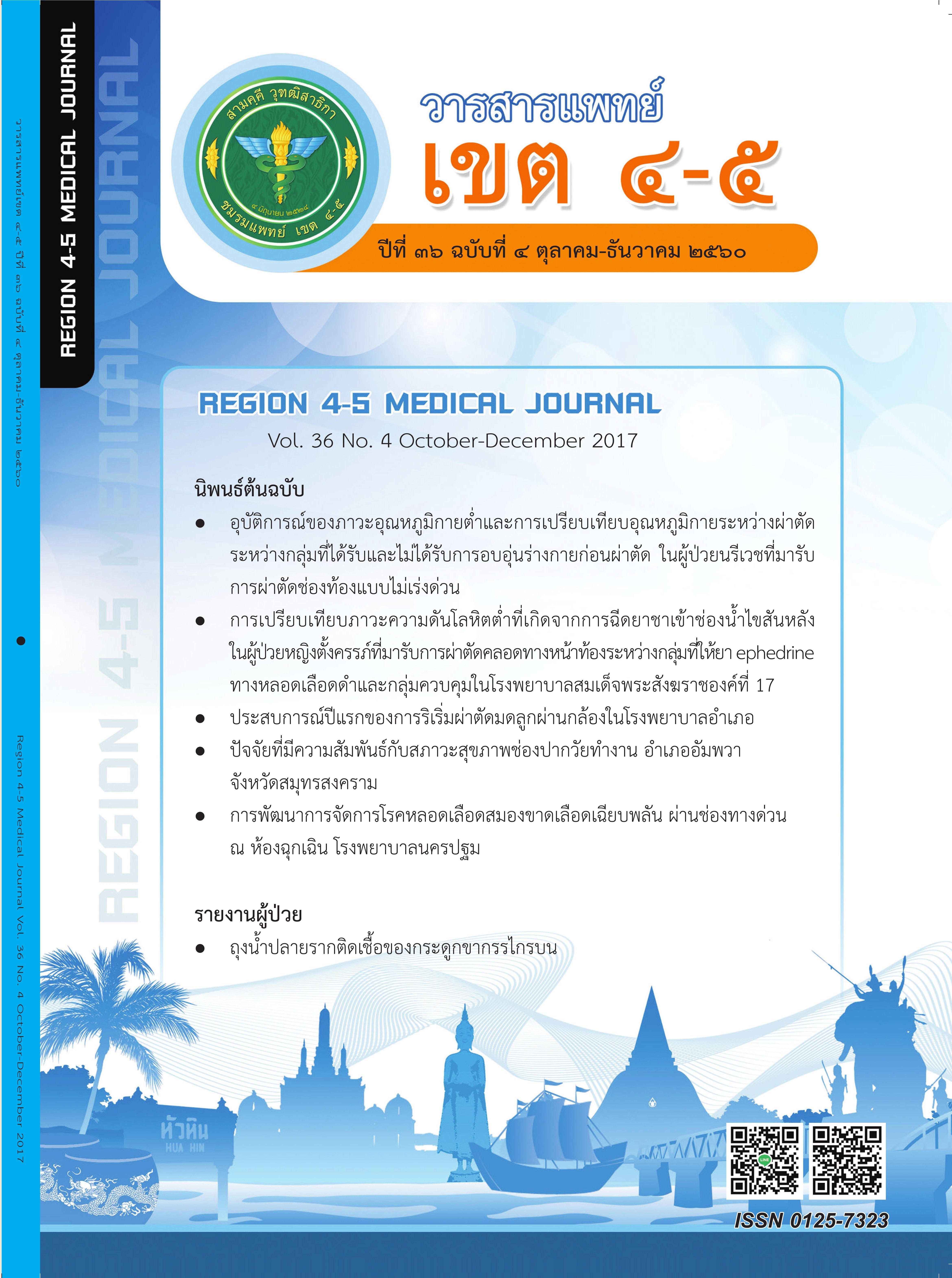ความแม่นยำของการตรวจทางเซลล์วิทยาโดยการเจาะดูดด้วยเข็มขนาดเล็กในการวินิจฉัยก้อนที่ต่อมน้ำลาย
คำสำคัญ:
ต่อมน้ำลาย, การตรวจเซลล์วิทยาโดยการเจาะดูดด้วยเข็มขนาดเล็ก, ความแม่นยำบทคัดย่อ
วัตถุประสงค์: เพื่อเปรียบเทียบผลตรวจทางเซลล์วิทยาด้วยเข็มขนาดเล็ก (fine needle aspiration cytology; FNAC) กับผลตรวจทางพยาธิวิทยา (histopathology) ของก้อนที่ต่อมน้ำลายหลังได้รับการผ่าตัด วิเคราะห์ข้อมูลคำนวณหาค่าความไว ความจำเพาะ และความแม่นยำของผล FNAC ในการวินิจฉัยมะเร็งต่อมน้ำลายเพื่อนำไปสู่การวางแผนการรักษา และช่วยประเมินภาวะแทรกซ้อนหลังการผ่าตัด
วิธีการศึกษา: การศึกษาย้อนหลังผู้ป่วยที่ได้รับการผ่าตัดต่อมน้ำลาย ณ กลุ่มงานโสต ศอ นาสิก โรงพยาบาลสมุทรสาคร ตั้งแต่วันที่ 1 มกราคม 2553 ถึง 30 พฤษภาคม 2560 พบมีผู้ป่วย 82 ราย เก็บข้อมูลพื้นฐานของผู้ป่วย ผลตรวจ FNAC ของต่อมน้ำลายก่อนผ่าตัด และผลตรวจทางพยาธิวิทยาหลังผ่าตัด นำข้อมูลมาวิเคราะห์คำนวณหาค่าความไว ความจำเพาะ และความแม่นยำของการทำ FNAC ในการวินิจฉัยมะเร็งต่อมน้ำลาย
ผลการศึกษา: ผล FNAC เพื่อวินิจฉัยมะเร็งต่อมน้ำลายมีความแม่นยำ ร้อยละ 95 ความไว ร้อยละ 50 ความจำเพาะ ร้อยละ 99 โอกาสที่ผู้ป่วยจะเป็นมะเร็งเมื่อผลตรวจเป็นบวกมีค่า ร้อยละ 75 และโอกาสที่ผู้ป่วยจะไม่เป็นมะเร็งเมื่อผลตรวจเป็นลบมีค่า ร้อยละ 96 เมื่อวิเคราะห์แยกตามตำแหน่งของต่อมน้ำลาย พบว่ามีความแตกต่าง โดยตำแหน่งต่อมน้ำลายหน้าหู มีความแม่นยำ ร้อยละ 93 ความไว ร้อยละ 25 และความจำเพาะ ร้อยละ 98 ส่วนตำแหน่งต่อมน้ำลายใต้ขากรรไกร มีความแม่นยำ ความไว และความจำเพาะ ร้อยละ 100 ซึ่งสูงกว่า ต่ำแหน่งต่อมน้ำลายหน้าหู เนื่องจากความแตกต่างของข้อบ่งชี้ในการทำ FNAC ขนาดและความลึกของก้อน อุบัติการณ์ของโรคที่พบและมะเร็งที่แตกต่างกันระหว่างต่อมน้ำลายทั้งสองตำแหน่ง
สรุป: ผล FNAC ต่อมน้ำลายมีความจำเพาะและความแม่นยำสูงในการวินิจฉัยมะเร็งต่อมน้ำลาย ทั้งที่ตำแหน่งต่อมน้ำลายหน้าหู และต่อมน้ำลายใต้ขากรรไกร มีประโยชน์ในการแนะนำแนวทางการรักษาให้กับผู้ป่วยช่วยวางแผนการผ่าตัดและช่วยประเมินภาวะแทรกซ้อนหลังการผ่าตัด
เอกสารอ้างอิง
2. Buley ID, Roskell DE. Fine-needle aspiration cytology in tumor diagnosis: uses and limitations. Clin Oncol (R Coll Radiol) 2000;12:166-71.
3. Zhang S, Bao R, Bagby J, et al. Fine needle aspiration of salivary glands: 5-year experience from a single academic center. Acta Cytol 2009;53:375-82.
4. Stewart CJ, MacKenzie K, McGarry GW, et al. Fine-needle aspiration cytology of salivary gland: a review of 341 cases. Diagn Cytopathol 2000;22:139-46.
5. Nguansangiam S, Jesdapatarakul S, Dhanarak N, et al. Accuracy of fine needle aspiration cytology of salivary gland lesions: routine diagnostic experience in Bangkok, Thailand. Asian Pac J Cancer Prev 2012;13:1583-8.
6. Ameli F, Baharoom A, Md Isa N, et al. Diagnostic challenges in fine needle aspiration cytology of salivary gland lesions. Malays J Pathol 2015;37:11-8.
7. Gupta R, Dewan D, Kumar D, et al. Fineneedle aspiration cytology (FNAC) of salivary gland lesions with histopathological correlation in a district hospital of Jammu region. Indian J Pathol Oncol 2016;3:32-7.
8. Gudmundsson JK, Ajan A, Abtahi J. The accuracy of fine-needle aspiration cytology for diagnosis of parotid gland masses: a clinicopathological study of 114 patients. J Appl Oral Sci 2016;24:561-7.
9. Bini F, Janhvi JB, Hiran KR. Reliability of Fine Needle Aspiration Cytology in salivary neoplasms: surgeon’s perspective. Amrita J Med 2014;10:23-9.
10. Hossain MA, Alam Z, Haque R, et al. Role of fine needle aspiration cytology in the preoperative diagnosis of malignancy in parotid and submandibular gland neoplasm. Bangladesh J Otorhinolaryngol 2013;19:110-8.
11. Venkateshwar P, Shalini T. Role of fine needle aspiration cytology in parotid tumours. Int J Adv Res 2015;3;1717-20.
12. Piccioni LO, Fabiano B, Gemma M, et al. Fine-needle aspiration cytology in the diagnosis of parotid lesions. Acta Otorhinolaryngol Ital 2011;31:1-4.
13. Singh Nanda KD, Mehta A, Nanda J. Fineneedle aspiration cytology: a reliable tool in the diagnosis of salivary gland lesions. J Oral Pathol Med 2012;41:106-12.
14. Qizilbash AH, Sianos J, Young JE, et al. Fine needle aspiration biopsy cytology of major salivary glands. Acta Cytol 1985;29:503-12.
15. Song IH, Song JS, Sung CO, et al. Accuracy of Core Needle Biopsy Versus Fine Needle Aspiration Cytology for Diagnosing Salivary Gland Tumors. J Pathol Transl Med 2015;49:136-43.
16. Jain R, Gupta R, Kudesia M, et al. Fine needle aspiration cytology in diagnosis of salivary gland lesions: A study with histologic comparison. Cytojournal 2013;10:5.
17. Omhare A, Singh SK, Nigam JS, et al. Cytohistopathological study of salivary gland lesions in bundelkhand region, uttar pradesh, India. Patholog Res Int 2014;2014:804265.
18. Mihashi H, Kawahara A, Kage M, et al. Comparison of preoperative fineneedle aspiration cytology diagnosis and histopathological diagnosis of salivary gland tumors. Kurume Med J 2006;53:23-7.
19. Iqbal M, Anwar K, Ihsanullah, et al. The diagnostic value of fine needle aspiration cytology in masses of the salivary glands. JPMI 2011;25:73-7.
20. Hughes JH, Volk EE, Wilbur DC, et al. Pitfalls in salivary gland fine-needle aspiration cytology: lessons from the College of American Pathologists Interlaboratory Comparison Program in Nongynecologic Cytology. Arch Pathol Lab Med 2005;129:26-31.
21. Parikh R, Mathai A, Parikh S, et al. Understanding and using sensitivity, specificity and predictive values. Indian J Ophthalmol 2008;56:45-50.
22. Laishram RS, Kumar KA, Pukhrambam GD, et al. Pattern of salivary gland tumors in Manipur, India: A 10 year study. South Asian J Cancer 2013;2:250-3.
23. Fassnacht W, Schmitz S, Weynand B, et al. Pitfalls in preoperative work-up of parotid gland tumours: 10-year series. B-ENT 2013;9:83-8.
24. Grimes DA, Schulz KF. Uses and abuses of screening tests. Lancet 2002;359:881-4.
25. Maxim LD, Niebo R, Utell MJ. Screening tests: a review with examples. Inhal Toxicol 2014;26:811-28.
26. Feinstein AJ, Alonso J, Yang SE, et al. Diagnostic Accuracy of Fine-Needle Aspiration for Parotid and Submandibular Gland Lesions. Otolaryngol Head Neck Surg 2016;155:431-6.
27. Liu CC, Jethwa AR, Khariwala SS, et al. Sensitivity, Specificity, and Posttest Probability of Parotid Fine-Needle Aspiration: A Systematic Review and Meta-analysis. Otolaryngol Head Neck Surg 2016;154:9-23.
ดาวน์โหลด
เผยแพร่แล้ว
รูปแบบการอ้างอิง
ฉบับ
ประเภทบทความ
สัญญาอนุญาต
ลิขสิทธิ์บทความเป็นของผู้เขียนบทความ แต่หากผลงานของท่านได้รับการพิจารณาตีพิมพ์ลงวารสารแพทย์เขต 4-5 จะคงไว้ซึ่งสิทธิ์ในการตีพิมพ์ครั้งแรกด้วยเหตุที่บทความจะปรากฎในวารสารที่เข้าถึงได้ จึงอนุญาตให้นำบทความในวารสารไปใช้ประโยชน์ได้ในเชิงวิชาการโดยจำเป็นต้องมีการอ้างอิงถึงชื่อวารสารอย่างถูกต้อง แต่ไม่อนุญาตให้นำไปใช้ในเชิงพาณิชย์




